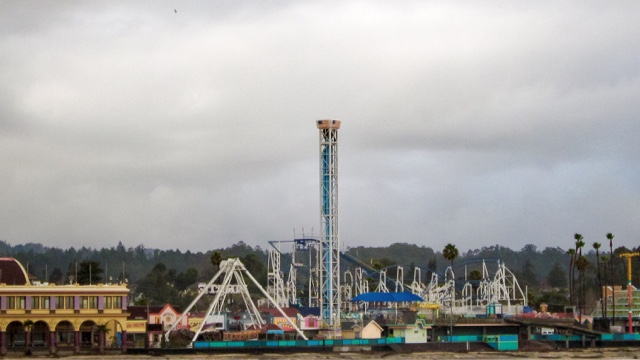Originally constructed to help with the shipping of potatoes to San Francisco during the Gold Rush, the Santa Cruz Wharf was opened on December 5th 1914. As roads improved and vehicles became more capable, the wharf primarily became the hub for the North Monterey Bay Fishing Industry. By the 1950s, as the fish population in the area dwindled, families became more able to travel and were looking for recreation. As a direct result of both of these factors, the Santa Cruz Wharf became a recreational destination.
The opening of a public bath by John Leibrandt at the mouth of the San Lorenzo River resulted in other baths being opened and becoming a popular tourist destination in the area. Many people journeyed to enjoy the natural, and what was also touted as medicinal, aspects of bathing in salt water. The popularity of the public bathhouses resulted in other concessions including restaurants, photo stands and curio shops opening.
Towards the end of the century Fred W Swanton, a famed entrepreneur and promoter, was commissioned to construct a casino and boardwalk beside the Santa Cruz Wharf. It was promoted as being the 'Coney Island of the West'. The first casino was built in 1904 but was destroyed by fire on June 22nd 1906. Although the building was uninsured, Swanton was able to get investors and hired the well-known architect, Wiliiam H. Weeks, to design the new casino. The new design included a ballroom, the Plunge, an indoor pool, a pleasure pier and a boardwalk. Exactly a year after the first casino burnt, the new attraction opened on June 22nd 1907. A huge ball with over 1,200 guests celebrated the opening. Thousands of people came out to see the thousands of lights illuminated as the attraction was opened.
In 1908 the first ride was opened. It was the L.A Thompson Scenic Railway. In 1911 famed Danish-born American, Charles ID Looff, delivered a new carousel to the boardwalk. Looff hand carved his carousels, and he was responsible for building the first carousels at Coney Island as well as many other famed carousels and rides at various amusement parks. The new carousel was fitted with a 342-pipe, 1894 Ruth Und Sohn band organ. The carousel is still fully functioning on the Santa Cruz Boardwalk.
Looff's son, Arthur, suggested that the Scenic Railway on the boardwalk be replaced by a more modern rollercoaster. In 1924 The Giant Dipper opened. The ride is still very popular on the boardwalk.
During prohibition in the 1930s, the casino changed its name to Cocoanut Grove, a play on the name of a popular 1929 Marx Bros movie "The Cocoanuts". The Cocoanut Grove became a popular spot for famous performers of the time, including Benny Goodman and Artie Shaw.
In the 1950s several rides, including the Wild Mouse and Autorama, were added to the boardwalk, and more renovations were carried out on The Cocoanut Grove. The Plunge indoor pool was replaced by a miniature golf course. An overhead ride giving views of the beach below, called the Sky Glider, was added in 1967. During the 1970s rides were renovated, and the Wild Mouse was replaced by a water ride called Logger's Revenge.
In the 1980s The Cocoanut Grove was thoroughly renovated, adding conference rooms and banquet areas. The Sun Room was built, providing a 6000-square-foot banquet room with a retractable glass roof that allows open-air dining and dancing. More shops and restaurants were opened on the boardwalk. In 1988, free summer concerts were held at the beach bandstand, a tradition that continues now.
In 1989, on October 17th, an earthquake damaged the building that once housed the Plunge, and so resulted in the construction of an adventure centre in its place, known now as Neptune's Kingdom. During the 1990s many rides were added, including Laser Tag in 1995.
The boardwalk now has 35 rides and attractions. The adjacent Santa Cruz Wharf offers restaurants and fishing, as well as gift shops. Just a short walk from the boardwalk is a world-class surf spot.
The original Plunge pool building, which now houses Neptune's Kingdom, is said to be haunted by two boys that apparently drowned in the pool. Staff at the boardwalk have reported "strange feelings" and the awareness of a "presence" in The Cocoanut Grove. An apparition known as "The Lady of the Sea" is said to haunt the Santa Cruz beaches. She is rumoured to have some involvement in the near drowning of several night surfers. She is said to be pale and dressed in black clothing, and is most often seen at dusk. It's been suggested that she drowned in a shipwreck, though no-one is sure which one.
There is also this strange video that shows someone standing on The Big Dipper as the ride is in progress. Some people say it's a ghost; some say it's a workman, which seems really dangerous as the ride is running. It's worth a look.
I stayed in Santa Cruz during very stormy weather, and it's a most beautiful place to spend some time.






















































